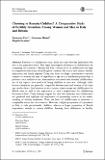Files in this item
Choosing to remain childless? A comparative study of fertility intentions among women and men in Italy and Britain
Item metadata
| dc.contributor.author | Fiori, Francesca | |
| dc.contributor.author | Rinesi, Francesca | |
| dc.contributor.author | Graham, Elspeth | |
| dc.date.accessioned | 2017-02-07T13:30:35Z | |
| dc.date.available | 2017-02-07T13:30:35Z | |
| dc.date.issued | 2017-07 | |
| dc.identifier | 246879465 | |
| dc.identifier | 965d1f09-7bb4-452a-977d-33df4671f320 | |
| dc.identifier | 85011615020 | |
| dc.identifier | 000404654600002 | |
| dc.identifier.citation | Fiori , F , Rinesi , F & Graham , E 2017 , ' Choosing to remain childless? A comparative study of fertility intentions among women and men in Italy and Britain ' , European Journal of Population , vol. 33 , no. 3 , pp. 319-350 . https://doi.org/10.1007/s10680-016-9404-2 | en |
| dc.identifier.issn | 0168-6577 | |
| dc.identifier.uri | https://hdl.handle.net/10023/10243 | |
| dc.description | This research was supported by the ESRC Centre for Population Change (grant number RES-625-28-0001 and ES/K007394/1). | en |
| dc.description.abstract | Pathways to childlessness may differ not only between individuals but also at the population level. This paper investigates differences in childlessness by comparing two countries – Britain and Italy – where levels of childlessness are high in comparison with many other European countries, but which have distinct fertility trajectories and family regimes. Using data from two large, representative national samples of women and men of reproductive age in a co-residential partnership, it presents a rich analysis of the characteristics associated with intended childlessness, net of the aspects associated with being childless at interview. Although childlessness intentions are generally comparable between men and women of the same age, results show a link between socio-economic disadvantage and childlessness for British men as well as the importance of men’s employment for childbearing decisions in Italy. These findings support the view that pathways into childlessness are gendered and highlight the importance of partnership context in the understanding of fertility intentions. Then, the level of childlessness at interview is comparable across the two countries. However, a higher proportion of respondents in Italy is only provisionally childless whereas a larger proportion of British respondents intends to remain childless. Framing these differences in fertility intentions within the wider context of family and fertility regimes allows insight into the extent to which observed levels of lifetime childlessness at the population level might result from a specific combination of intended childlessness, postponed decisions leading to involuntary childlessness, or constraints affecting individual abilities to achieve their intentions at the individual level. | |
| dc.format.extent | 32 | |
| dc.format.extent | 559637 | |
| dc.language.iso | eng | |
| dc.relation.ispartof | European Journal of Population | en |
| dc.subject | Childlessness intentions | en |
| dc.subject | Italy | en |
| dc.subject | Britain | en |
| dc.subject | Gender differences | en |
| dc.subject | H Social Sciences | en |
| dc.subject | BF Psychology | en |
| dc.subject | GF Human ecology. Anthropogeography | en |
| dc.subject | 3rd-DAS | en |
| dc.subject | BDC | en |
| dc.subject.lcc | H | en |
| dc.subject.lcc | BF | en |
| dc.subject.lcc | GF | en |
| dc.title | Choosing to remain childless? A comparative study of fertility intentions among women and men in Italy and Britain | en |
| dc.type | Journal article | en |
| dc.contributor.sponsor | Economic & Social Research Council | en |
| dc.contributor.sponsor | Economic & Social Research Council | en |
| dc.contributor.institution | University of St Andrews. Geography & Sustainable Development | en |
| dc.contributor.institution | University of St Andrews. Centre for Population Change | en |
| dc.identifier.doi | 10.1007/s10680-016-9404-2 | |
| dc.description.status | Peer reviewed | en |
| dc.date.embargoedUntil | 2017-02-03 | |
| dc.identifier.grantnumber | ES/K007394/1 | en |
| dc.identifier.grantnumber | ES/G027153/1 | en |
This item appears in the following Collection(s)
Items in the St Andrews Research Repository are protected by copyright, with all rights reserved, unless otherwise indicated.

